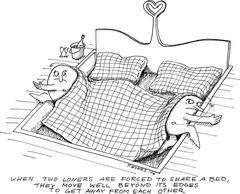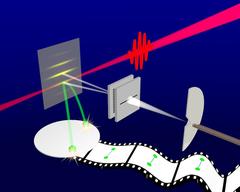URL: https://www.desy.de/news/news_search/index_eng.html
Breadcrumb Navigation
DESY News: Partnership at a distance: deep-frozen helium molecules
News
News from the DESY research centre
Partnership at a distance: deep-frozen helium molecules
Helium atoms are loners. Only when you cool them to very low temperatures do they form extremely weakly bonded molecules. Yet even in this state, they are able to maintain an extremely large separation from each other thanks to quantum tunnelling. With the help of DESY’s free-electron laser FLASH, Frankfurt nuclear physicists have been able to confirm that the atoms spend more than 75 percent of their time so far apart from each other that their bond can only be explained by means of quantum tunnelling. The scientists have presented their findings in the US journal “Proceedings of the National Academy of Sciences” (PNAS).

Credit: Peter Evers
Dörner’s group has produced these helium molecules in an experiment and studied them using the COLTRIMS reaction microscope developed at the Goethe University. They determined the strength of the bond at FLASH to a hitherto unparalleled degree of precision as well as measuring the distance between the two atoms forming the molecule. “In a sense, the helium molecule is a touchstone for quantum theory, because the binding energy predicted by theory is extremely sensitive to how carefully all the different physical and quantum-mechanical effects have been taken into account,” says Dörner. Even the theory of relativity, which is otherwise used primarily for astronomical calculations, needs to be included. “The smallest error in the calculations can lead to large deviations in the results or they may even predict that the helium molecule cannot exist at all,” notes Dörner. The high-precision measurements carried out by his group will serve as a reference for future experiments.

Experimental setup: The helium molecules are generated in an extremely cool gas stream and are separated in a diffraction grating from the rest of the gas jet. FLASH's X-rays (red) ionize both helium atoms of the molecule, causing them to separate in an explosive manner. The ions are then imaged on a location-resolving detector, symbolised by the film strip. The wave function is then reconstructed from a multitude of individual images. Credit: Reinhard Dörner / Goethe-University Frankfurt
The next PhD student, Stefan Zeller, was able to make some further crucial improvements to the apparatus, with the help of Maksim Kunitski, thereby increasing the precision of the measurements. One of the tricks he used was to fire the extremely intense beam produced by FLASH at the extremely weakly bonded helium molecules. Reinhard Dörner, who supervised Zeller’s PhD, remarks that “Stefan Zeller’s achievement was very impressive. His success would not have been possible without his tireless efforts, his tremendous experimental skills and his ability not to be discouraged by temporary setbacks.”
The findings have already received great international and national attention and in addition they form part of the research for which the group was awarded the Helmholtz Prize in 2016.
Reference
Imaging the He2 quantum halo state using a free-electron laser; S. Zeller, M. Kunitski, J. Voigtsberger, A. Kalinin, A. Schottelius, C. Schober, M. Waitz, H. Sann, A. Hartung, T. Bauer, M. Pitzer, F. Trinter, C. Goihl, C. Janke, M. Richter, G. Kastirke, M. Weller, A. Czasch, M. Kitzler, M. Braune, R. E. Grisenti, W. Schöllkopf, L. Ph. H. Schmidt, M. Schöffler, J. B. Williams, T. Jahnke, and R. Dörner; „PNAS“, 2016; DOI: 10.1073/pnas.1610688113



